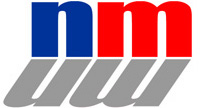

Liquid crystal displays (LCDs) have become quite common in watches due to the low electrical power demands of the LCD panel. This panel is composed of two polarizers that transmit light in perpendicular directions, a mirrored surface and a layer of liquid crystal material that is sandwiched between two electrically conducting glass plates. The liquid crystal material used is of the so-called twisted nematic type.

| Figure 2. The liquid crystal molecules in all segments of
the panel are precisely aligned in the absence of an applied voltage. Therefore, the entire panel appears silvery because light passes through both polarizers, reflects off the mirrored surface, and then passes back through both polarizers. |
If the surfaces of the glass plates that will be in contact with the liquid crystal molecules are rubbed, the liquid crystal molecules orient in the direction of the rubbing. Figure 2 shows that the molecules have been oriented in the direction in which the adjacent polarizer transmits light, and the intervening molecules gradually rotate their relative orientation to accommodate the 90o change from one polarizer to the other. This gives a silvery appearance to the panel, Figure 2.

| Figure 3. The initial alignment of the liquid crystal molecules
is lost when a voltage is applied to a segment of the panel. That segment will then appear black against a silver background. |
When a voltage is applied to a segment of the display, the precise alignment of the liquid crystal molecules is lost. This results in the polarized light from the first polarizer not being rotated by the required 90o to align with the second polarizer. The second polarizer blocks the passage of light and causes that segment of the panel to appear black, Figure 3.

| Figure 4. Examples of 7-segment numeric and 14-segment alphanumeric displays. |
Most of the displays in LCD watches are composed of several 7-segment sections. Each 7-segment section can display one number. The combination of these sections can display the date or time, Figure 4.
[Experiment with Polarizers] back | forward [Watch Components]